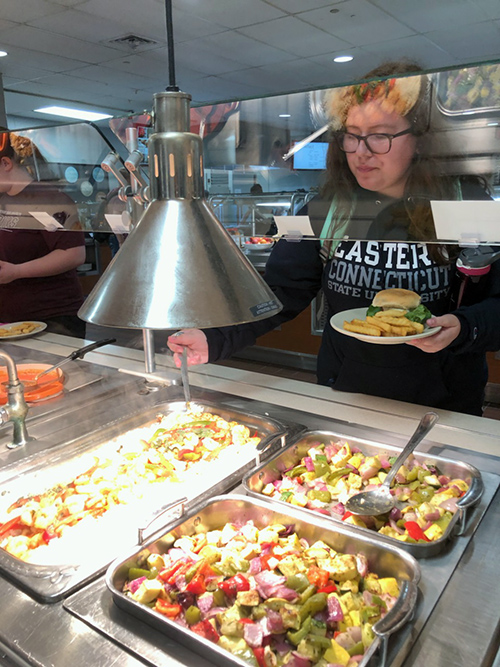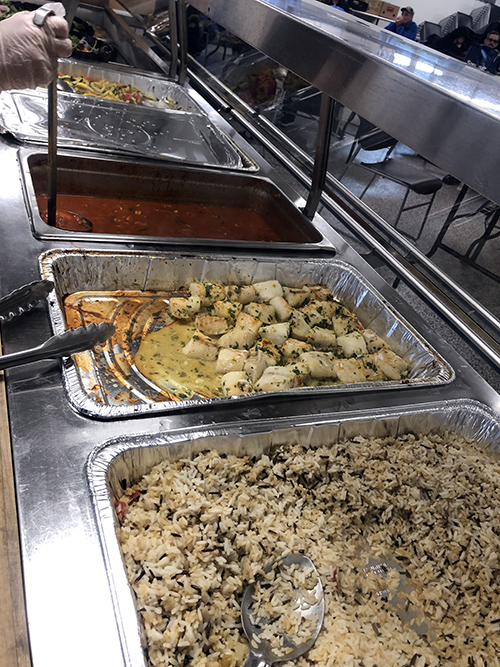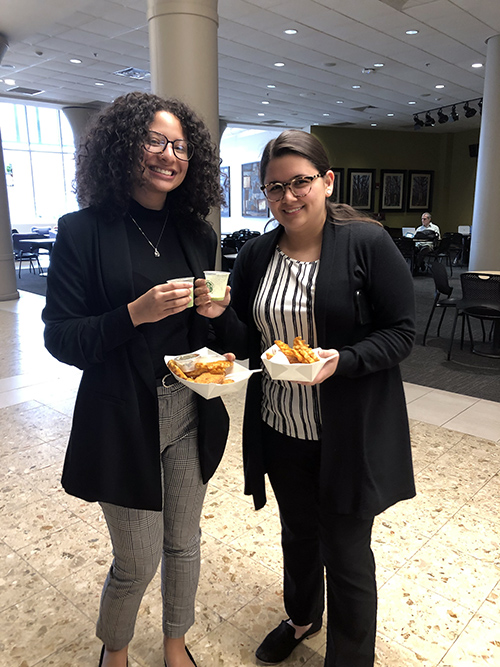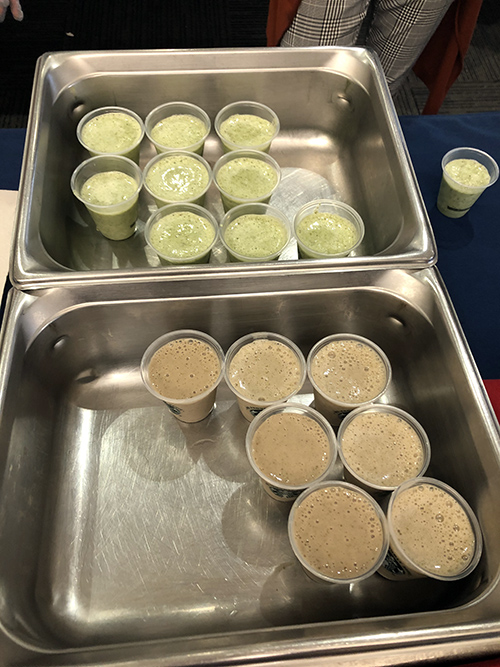- Apply
- Visit
- Request Info
- Give
Eastern Dining Initiatives Bring Seaweed, Underused Fish to Campus
Written by Michael Rouleau
Published on March 24, 2020
Eastern Connecticut State University and three partnering universities are nearing the end of a two-year, $500,000 effort to incorporate underused foods from the ocean into the dining culture of their respective campuses. The Henry P. Kendall Foundation awarded two Food Vision Prizes of $250,000 each to the four universities - including Eastern, the University of Massachusetts-Dartmouth, Northeastern University and Massachusetts Maritime Academy - to increase the consumption of kelp and underutilized fish on campus.
The four universities are connected via the food service provider Chartwells, which was awarded the Food Vision Prizes in 2018. The two projects, which are meant to foster a shift toward sustainable seafood while supporting the local fishing and kelp farming industries, launched in fall 2019 and will conclude this April.
One project focuses on local fish, such as scup, hake, whiting, pollock and monkfish, which are prolific yet remain underutilized in mainstream cuisine. The other project focuses on kelp, which is a relatively unknown yet abundant sea vegetable with many nutritional and environmental benefits. Together, these food sources represent a sustainable food system with benefits to the regional maritime economy.
For the underutilized fish project, the universities have committed to locally sourcing 75 percent of all fish that they serve on campus, according to a Kendall Foundation press release. To improve the sourcing and purchasing systems that incorporate these fish onto campus menus, Chartwells partnered with regional providers including Ipswich Fish, Red's Best, Farm Fresh Rhode Island and Buyers & Sellers Seafood Auction (BASE).
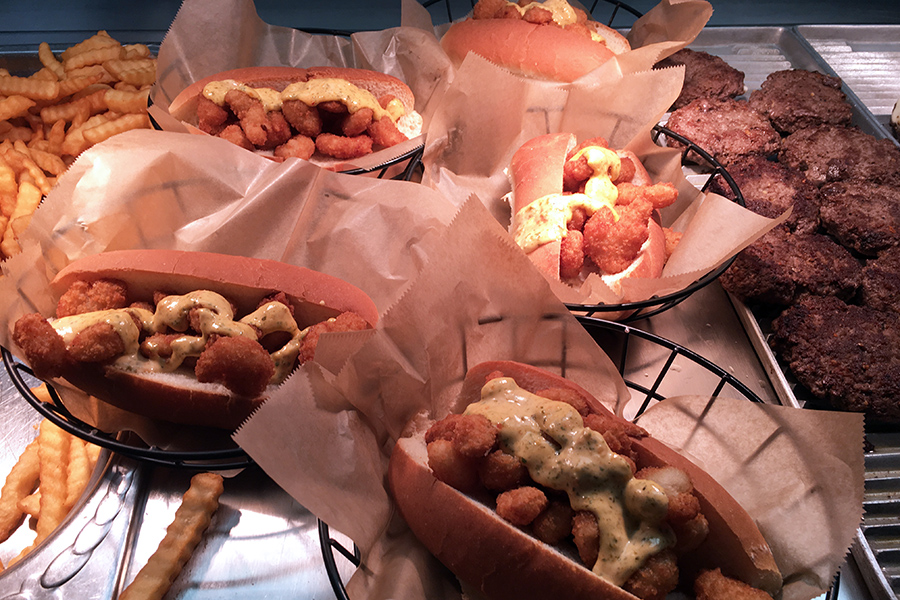
The partnership with Red's Best has proved especially beneficial, according to Conor Dodd, Chartwells executive chef at Eastern. "They're now an approved vendor through our food supplier, which gives us access to their catch of the day," which arrives fresh within 24 hours of catching.
Dodd says that transitioning students to underutilized fish has been easy. Monkfish, for instance, is a sturdy fish that does well in stews and chowders. He says that the other varieties have been well-received, too, as they cook like any other flaky white fish. Students got their first taste of underutilized fish - monkfish chowder - at the fall 2019 President's Picnic and Student Activities Fair.
For the kelp project, Chartwells partnered with Farm Fresh Rhode Island, Sardilli Produce and Dole & Bailey. Chartwells has worked to increase awareness of kelp by featuring more of it on campus menus and developing a marketing strategy to communicate its benefits, which include being nutrient rich, high in protein and low in calories.
Over the duration of the project, the four universities have incorporated kelp into dining hall menus multiple times per month and added kelp to retail salad bars, soups and other retail stations.
With the help of students, Chartwells has held events to promote kelp in Eastern's Student Center. Two such events featured kelp smoothies. "It may seem weird, but it's healthy and sustainable," said student Torin Radicioni, who handed out samples of chocolate-banana and "flu fighter" smoothies infused with kelp.
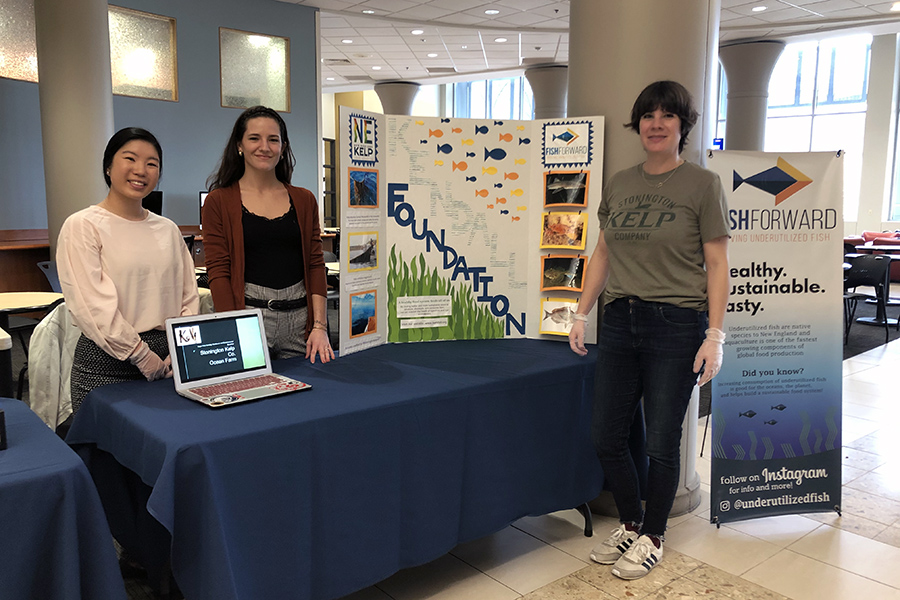
"Kelp has been a harder sell," admits Dodd, who incorporates it into dishes by substituting it with greens such as kale and spinach. Another popular Student Center tasting featured kelp slaw with beer-battered dog fish and chips.
Hard sell or not, Tom Kilgus, Chartwells retail dining director at Eastern, reports that the campus went from zero kelp usage to approximately 200 pounds this academic year.
While Dodd has focused on menu implementation and recipe development, Kilgus has focused on education and outreach. He's also expanded the effort beyond campus, working with the Connecticut Chefs Association to involve chefs-in-training with recipe development.
"There are a lot of chefs interested in using kelp," said Kilgus of the underused sea vegetable. "People just don't know how." He explained that kelp generally comes in two forms: concentrated cubes and kelp slaw. "The cubes are good for infusing (kelp smoothies); the slaw comes shredded and is good for salads."
Through Eastern's allocation of Food Vision funding, trainees in the Connecticut Chefs Association have created several recipes, including miso soup with kelp, seaweed-topped salmon, maple-glazed kelp and carrots, and seaweed-stuffed cabbage. Back on campus, one of Dodd's favorite creations is an energy bar recipe consisting of chickpeas, almond butter, honey and, of course, kelp.
Integral to the projects' outreach efforts were Eastern students Emily Chu and Amber Mohr, who interned with Chartwells to advance the Food Vision initiatives.
Chu, who double majors in business administration and communication, served as an event coordinator and community liaison. She was key in bringing kelp and underutilized fish dishes to the Covenant Soup Kitchen in downtown Willimantic for a kitchen-takeover event that fed more than 100 people.
Speaking to the internship, she said, "Not only am I developing skills and work experience, but I'm learning about different ways to use kelp and underutilized fish. It's also interesting to learn how much of a benefit kelp has on the environment and to our bodies."
A biology major, Mohr researched and presented on the nutritional and environmental benefits of kelp/shellfish farming and using underutilized fish. "I'm also doing research on using more underutilized fish so it doesn't go to waste," she said. "This internship has allowed me to help others learn more about sustainable food sources."
In their campaign to promote these underused ocean foods, the students presented information such as "Underutilized fish is highly nutritious and often lower in mercury than other fish"; "Using underutilized fish is cost-effective and reduces waste"; "Kelp contains fibers and sugars that increase growth of good bacteria and nourish the gut"; "Kelp/seaweed has 10 times more minerals than land-based plants; it's also rich in vitamins, antioxidants and omegas."
The Food Vision projects are set to formally conclude this April, but Eastern and Chartwells intend to continue the projects' goals of supporting the local fishing and kelp farming industries. According to Kilgus, the summation of our work will be a book of recipes for kelp and underutilized fish that will be bundled with a care package of kelp cubes and slaw, which will be sent to other Chartwells clients.
The goal of the Henry P. Kendall Foundation is to create a resilient and healthy food system in New England that increases the production and consumption of local, sustainably produced food. The Kendall Foundation intends to award Food Vision Prizes through 2023, providing up to $6 million in funding.



